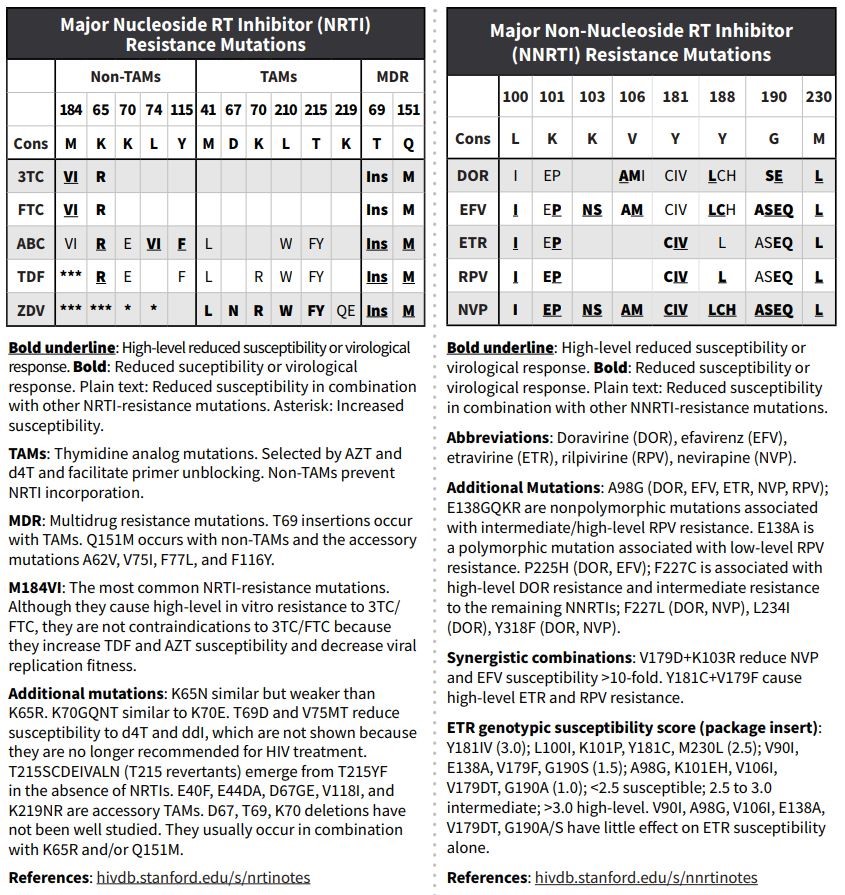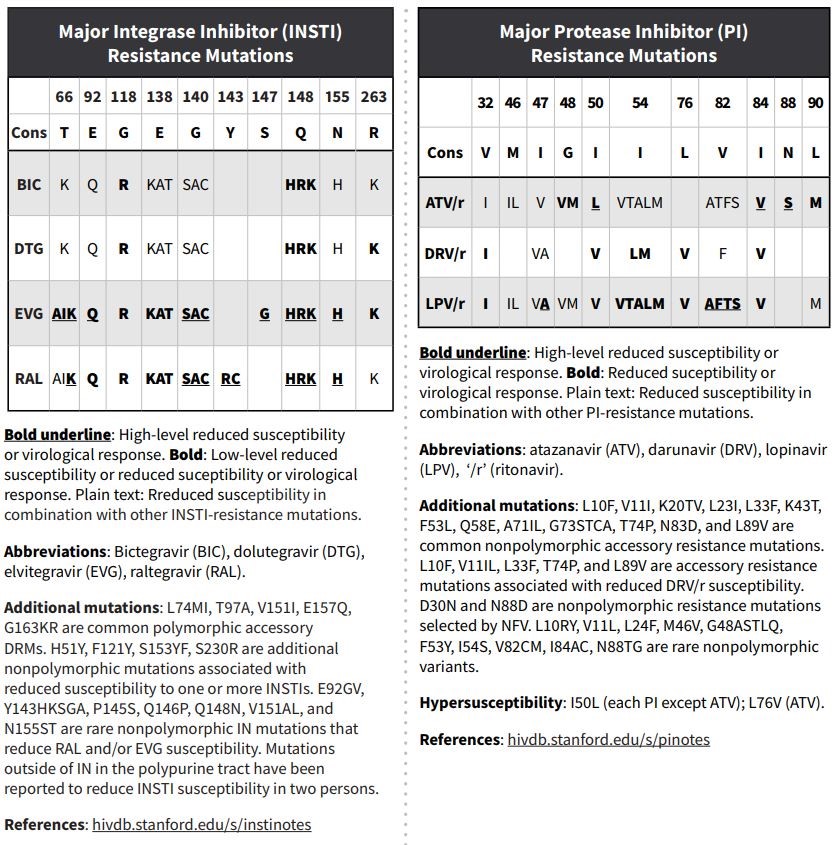How to Determine Resistance to Art Therapy in Hiv
HIV shows a high rate of genomic evolution due to the error-prone nature of RT (which introduces random sequence changes into newly produced viral RNA)[23], the high rate of viral production, and the rapid turnover of productively infected cells. For these reasons HIV strains rapidly develop resistance to antiretroviral monotherapy through the acquisition of mutations in RT, envelope or protease genes that confer resistance of enzymatic part to the furnishings of the drug on the enzyme. The principle backside combination antiretroviral therapy (cART) is to achieve a depression level of viral replication and thus a reduced opportunity for the introduction of advantageous mutations into newly produced viruses. Strains that have mutated to go resistant to one therapeutic agent may also have abnormally lowered replicative capacity (fitness), making the acquisition of mutations to further agents less probable.
The resistance profile of a viral strain tin can be estimated by examination of the nucleic acid sequence of the target genes for evidence of known resistance mutations, or directly assessed past tissue culture of the virus (total length or cloned into a common viral backbone) in the presence of a panel of antiretroviral drugs. Treatment may so exist contradistinct in the noesis that a patient is carrying a virus resistant to one or more agents. Studies take demonstrated improved virological outcomes in patients whose therapeutic choices have been guided past the apply of resistance testing[24] [25] [26] [27] [28] [29] [30] and the utilize of resistance testing is regarded every bit standard of care in Australia, western Europe and the USA[31] [32].
At that place are a number of commercially available methods for determining the resistance profile of an HIV isolate. The most common is genotypic resistance testing, which is the just assay routinely available in Australia and is supported past the Medicare Benefits Schedule (MBS). Samples submitted for genotypic antiretroviral resistance testing should be accompanied by a request for a plasma HIV RNA level and a treatment history to aid in the estimation of test results.
Antiretroviral drug resistance genotyping
Assessment of the HIV genotype (i.e. the nucleic acrid sequence) involves the isolation of viral RNA followed by the RT-PCR amplification of portions of the target genes. These amplification products are and then sequenced using standardised automated DNA sequencing procedures. Ultracentrifugation of a plasma sample with a low HIV viral load (thousand - 2000 copies/mL) will pellet free virus for RNA extraction and sequencing. Examination sequences are compared with a wild-type control reference strain (i.east. no prior exposure to antiretroviral agents) for annotating differences in the predicted amino acrid sequences. Mutations that have been associated with resistance to antiretroviral drugs are then identified by comparison with a database of known codon (genetic code) mutations. Resistance mutations are commonly reported as principal (generally associated with phenotypically detectable drug resistance) or secondary (mutations generated after the chief mutation, and which may confer varying levels of resistance). The nomenclature of mutations is the wild-type amino acid (using the 20 alphabetic character amino acid lawmaking)/the amino acid position in the protein/the mutant amino acid eastward.g. for a change from the wild- type methionine residue at position 46 of protease to isoleucine is denoted M46I. Mutations that involve the insertion of amino acids follow similar classification with the additional amino acids post-obit the residue position. Tables two and iii show HIV resistance mutations to the classes of antiretroviral agents.
Caution must be exercised in the interpretation and employ of resistance genotyping data. Two major factors contribute to the complexity of this process: the contribution of small-scale species and mutational complexity. It is important to realise that genotypic resistance testing gives a snapshot of the dominant viral forms circulating in the plasma at the time of testing. Viral variants with different resistance profiles may circulate at depression levels or be present latently in proviral DNA. These may chop-chop re-appear and become dominant one time the selective pressure of antiretroviral therapy changes. Just minor species that are circulating at substantial levels (above about 20%) may be detected and reported. For this reason, genotypic resistance data must always be interpreted in the light of a thorough history of treatment and previous resistance testing.
Mutations are associated with drug resistance on the ground of in vitro or in vivo data. These data are non ever clear and the publication of new evidence means the assignment of mutation to phenotype is being continuously updated. The substantial sequence variability betwixt HIV strains means that information technology can be difficult to distinguish naturally occurring viral variants from selected mutations that confer an evolutionary advantage, especially if this reward is pocket-size or secondary to the existence of a primary mutation. When in doubtfulness, consultation with the laboratory performing the assay is strongly indicated.
Table ii. HIV antiretroviral drug resistance mutations: nucleoside/nucleotide reverse transcriptase inhibitor (NRTI) and non-nucleoside/nucleotide reverse transcriptase inhibitor (NRTI) mutations

Source: adapted from Standford University HIV Drug Resistance Database. For most electric current details of estimation, please refer to http://hivdb.stanford.edu
Table 3. HIV antiretroviral therapy resistance mutations: protease inhibitor and integrase inhibitor mutations.

Source: adjusted from Standford University HIV Drug Resistance Database. For most current details of interpretation, please refer to http://hivdb.stanford.edu
Resistance phenotyping
Phenotypic drug resistance is considered the gilded standard test for drug susceptibility and directly measures the competency of a virus isolate to grow in various concentrations of antiretroviral drugs. Phenotypic drug resistance assays are not routinely performed due to availability, lengthy turn-around time for results and cost. Nucleic acrid sequences from the various target genes of HIV are extracted from patient plasma HIV RNA and are inserted into the backbone of a laboratory clone of HIV or used to generate pseudotyped viruses that express the patient-derived HIV genes of interest. Replication competence of the pseudotyped viruses at increasing drug concentrations is monitored by expression of a reporter gene and is compared with replication of a reference wild-type HIV strain. The antiretroviral drug concentration that inhibits viral replication by 50% is calculated, and the ratio of the IC50 (inhibitory concentration) of examination and reference viruses is reported equally the fold increment in resistance. The addition of phenotypic to genotypic testing is more often than not preferred for persons with known or suspected complex drug-resistance mutation patterns, peculiarly to protease inhibitors (PIs)[33].
Source: https://hivmanagement.ashm.org.au/virological-tests/antiretroviral-drug-resistance-testing/
0 Response to "How to Determine Resistance to Art Therapy in Hiv"
Post a Comment